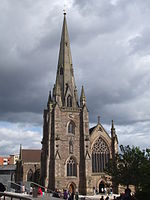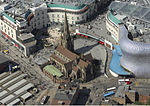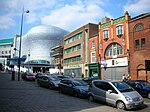Birmingham Moor Street railway station

Birmingham Moor Street, also known as Moor Street station, is one of three main railway stations in the city centre of Birmingham, England, along with Birmingham New Street and Birmingham Snow Hill. Today's Moor Street station is a combination of the original station, opened in 1909 by the Great Western Railway as a terminus for local trains, and a newer Moor Street station with through platforms, a short distance from the original, which opened in 1987, replacing the original. The two were combined into one station in 2002, when the original was reopened and restored, and the newer station rebuilt in matching style. Moor Street has become more important in recent years; two of the original terminus platforms were reopened in 2010, and the station is now the terminus of many Chiltern Railways services from London Marylebone, as well as being an important stop for local services on the Snow Hill Lines. It is now the second busiest railway station in Birmingham.
Excerpt from the Wikipedia article Birmingham Moor Street railway station (License: CC BY-SA 3.0, Authors, Images).Birmingham Moor Street railway station
Park Street, Birmingham Digbeth
Geographical coordinates (GPS) Address Nearby Places Show on map
Geographical coordinates (GPS)
| Latitude | Longitude |
|---|---|
| N 52.4787 ° | E -1.8919 ° |
Address
Platform 3
Park Street
B5 6BH Birmingham, Digbeth
England, United Kingdom
Open on Google Maps










